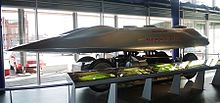- Railton Special
-
Railton Special,
later the Railton Mobil SpecialProduction one-off Body style streamlined fully enclosed "turtle shell" Engine Twin W12-block Napier Lion aero engines Transmission Separate drives to front and rear axles Length 28 ft 8 in (8.74 m) Width 8 ft (2.4 m) Height 4 ft 3 in (1.30 m) Curb weight over 3 tonnes Designer Reid Railton Modern Lledo toy of the Railton Mobil Special
The Railton Special, later rebuilt as the Railton Mobil Special, is a one-off motor vehicle built for John Cobb's successful attempts at the land speed record.
It was powered by two supercharged W12-block Napier Lion VIID (WD) aircraft engines. [1] These engines were the gift of Betty 'Joe' Carstairs, who had previously used them in her powerboat Estelle V.[2] Multiple engines was not a new technique, having already been used by the triple-engined White Triplex and the Railton Special's contemporary rival, Captain Eyston's twin-engined Thunderbolt. With the huge powers thus available, the limitation was in finding a transmission and tyres that could cope. Reid Railton found a simple and ingenious solution to this by simply splitting the drive from each engine to a separate axle, giving four wheel drive.
On 15 September 1938, the Railton Special took the land speed record from Thunderbolt at 353.30 mph (568.58 km/h), also being the first to break the 350 mph (560 km/h) barrier. Eyston re-took the record within 24 hours (357.50 mph / 575.34 km/h), holding it again until Cobb took it a year later on 23 August 1939 at a speed of 369.70 mph (594.97 km/h).
After the Second World War further development and sponsorship by Mobil Oil led to re-naming as the 'Railton Mobil Special'. It was the first ground vehicle to break 400 mph (640 km/h) in a measured test. On September 16, 1947 John Cobb averaged 394.19 mph (634.39 km/h) over the measured mile in both directions to take the world land speed record.
It weighed over 3 tonnes and was 28 ft 8 in (8.74 m) long, 8 ft (2.4 m) wide and 4 ft 3 in (1.30 m) high. The front wheels were 5 ft 6 in (1.68 m) apart and the rear 3 ft 6 in (1.07 m). The National Physical Laboratory's wind tunnel was used for testing models of the body.[3] It was designed by Reid Railton and is currently on display at the Thinktank museum in Birmingham, England.
Notes
- ^ 400 MPH on Land, Motor September 24, 1947 reproduced in Compiled by R M Clarke. The Land Speed Record 1940-1962. Brooklands Books. ISBN 1-85520-516-5.
- ^ Charles Jennings (2005). The Fast Set. Abacus. ISBN 0349115966.
- ^ Paul Clifton, The Fastest Men on Earth: The Men and Cars That Smashed the World Land Speed Record, London: Herbert Jenkins, 1964
References
- "The fastest car in the world". Birmingham Stories. http://www.birminghamstories.co.uk/story_page.php?id=4&type=fo&page=1&now=0.
- "Railton Mobil Special". Thrust SCC. http://www.thrustssc.com/thrustssc/History/Railton.html.
- "Press release - Railton Mobil Special". Thinktank. http://www.thinktank.ac/aboutus/press_stories/pressstory2001_07_01_d.htm.
- "Railton Special at Brooklands". Brooklands photo archive. probably 1938. http://www.brooklandsarchives.com/Gallery_N2/target36.html.
- "Railton Special at Brooklands". Brooklands photo archive. probably 1938. http://www.brooklandsarchives.com/Gallery_N2/target37.html.
Categories:- Vehicles designed by Reid Railton
- Vehicles powered by Napier Lion engines
- Wheel-driven land speed record cars
Wikimedia Foundation. 2010.


